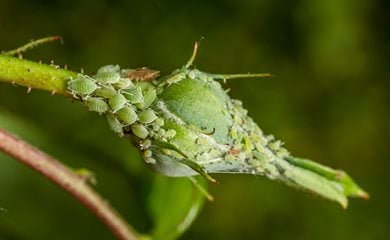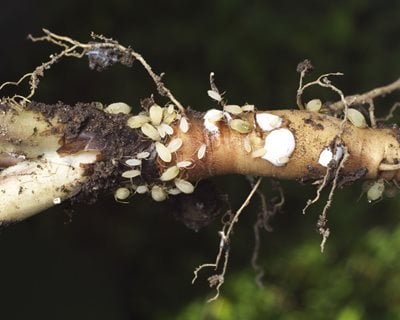HOW TO GET RID OF APHIDS NATURALLY
Four aphid control options that are safe for your plants and family
- Remove aphids by hand by spraying water or knocking them into a bucket of soapy water.
- Control with natural or organic sprays like a soap-and-water mixture, neem oil, or essential oils.
- Employ natural predators like ladybugs, green lacewings, and birds.
- Grow the right plants that attract predatory insects, plants that repel aphids, and plants that "trap" aphids.
There are many ways to control aphids without using dangerous chemicals in your garden. Aphids have several natural enemies, including other insects, insect larvae, and birds; and they move rather slowly, making them easy to remove by hand or target with sprays. Aphids multiply quickly, so it may take a combination of methods as well as repeated efforts to completely control them. Be persistent and patient; it may take a little time to see results.
Here are a few methods for natural aphid control:
GET RID OF APHIDS BY HAND
Water:
Spray aphids off of plants with a strong stream of water from a garden hose. This method is most effective early on in the season before an infestation has fully taken hold. It may not be a good choice for younger or more delicate plants, but it works well on plants where you can use higher water pressure.
Remove by hand:
Put on some garden gloves and knock them off of stems, leaves, flower buds, or wherever you see them, and into a bucket of soapy water to kill them. You can also cut or prune off the affected areas and drop them into the bucket.
CONTROL APHIDS WITH NATURAL AND ORGANIC SPRAYS
Soap and water:
Make a homemade aphid spray by mixing a few tablespoons of a pure liquid soap (such as castile) in a small bucket of water. (Avoid using detergents or products with degreasers or moisturizers.) Apply with a spray bottle directly on aphids and the affected parts of the plant, making sure to soak the undersides of leaves where eggs and larvae like to hide. The soap dissolves the protective outer layer of aphids and other soft-bodied insects, eventually killing them. It doesn’t harm birds or hard-bodied beneficial insects like lacewings, ladybugs or pollinating bees. You can also purchase ready-to-use insecticidal soaps online or at a local nursery.
Neem oil:
The organic compounds in neem oil act as a repellent for aphids and other insects, including mealybugs, cabbage worms, beetles, leafminers, ants and various types of caterpillars. However, it may repel beneficial insects, so use caution when and where they are present. Follow package instructions for diluting the oil in water or use a ready-to-use neem oil spray, and spray the affected areas. Neem oil is also good for controlling different types of fungus. Read more on how to use neem oil.
Essential oils:
Create your own spray mixture with essential oils. Use 4 to 5 drops of each: peppermint, clove, rosemary and thyme, and mix with water in a small spray bottle. Spray on affected plants to target adult aphids, as well as aphid larvae and eggs.
EMPLOY NATURAL PREDATORS

Pictured Left: Green lacewing larva. Photo by: Tomasz Klejdysz / Shutterstock.
Pictured Right: Lady beetle larva. Photo by: Geoffrey Budesa / Shutterstock.
Lady beetles:
Adult lady beetles (ladybugs) don't eat nearly as many aphids as they do in their larval stage, which is why many people are disappointed with the lack of control they see after releasing purchased live ladybugs into their garden.
There needs to be a large enough aphid population to keep the ladybugs fed long enough to mate and lay eggs — because it’s the larvae that eat the most aphids. Ladybug larvae don’t look at all like the adults we're so familiar with, so identification is important (see photo). Live ladybugs can be purchased online or at your local nursery.
Tips for better results:
- Lightly mist plants before releasing to encourage them to stop for a drink as they are probably dehydrated.
- Release them in cooler times of the day, early morning or evening.
- Repeat applications are needed, as most will fly away within a few days.
Green lacewings:
As with ladybugs, green lacewing larvae do the work of controlling aphids. Green lacewing eggs can also be purchased online and sometimes at a local nursery.
Birds:
Provide houses for bug-eating birds, like wrens and chickadees, to live in and they’ll repay you by helping keep the insect population under control. Grow small trees and shrubs where they can take cover and build their own nests.
Learn more about beneficial garden insects.
GROW THE RIGHT PLANTS
Use plants to your advantage by planting varieties that attract beneficial insects (aphid predators) or those that naturally repel aphids. You can also plant some aphid favorites as trap plants to lure aphids away from plants you are trying to protect. Also, keep your garden clean of dead plant material that may be harboring aphid eggs over winter.
- Attract beneficial insects: Clover, mint, dill, fennel, and yarrow
- Natural aphid repellents: Catnip, garlic, chives, onion, and allium
- Aphid trap plants: Zinnias, dahlias, cosmos, asters, mustard and nasturtium
What about aphids on roses?
Aphids love roses and can mount a major attack quickly, so keep a close eye on your rose bushes. Aphids like to gather on and below rosebuds, as well as under leaves. Learn more about how to get rid of aphids on roses.
How do you get rid of aphids on tomato plants?
In addition to the above methods of control, you can grow tomato companion plants that will deter aphids. These include marigolds, lavender, basil and chives.
Get seasonal plant information, gardening solutions, design inspiration, and more delivered weekly to your inbox.
APHIDS 101
Aphids feed on soft stems, branches, buds and fruit, preferring tender new growth over tougher established foliage. They pierce the stems and suck the nutrient-rich sap from the plant, leaving behind curled or yellowed leaves, deformed flowers, or damaged fruit. Most aphids feed on a wide variety of plants, although some species are specific to certain types of plants.
Aphids don’t like to dine alone, and can usually be found feeding in large groups. Depending on the level of infestation, they can cause serious injury to individual plants or even entire crops. Aphids produce multiple generations in one year and infestations can quickly get out of hand. Treating them early, before they have a chance to reproduce, can make a huge difference in gaining aphid control. Aphids frequently carry viruses and can spread them from one plant to another, often proving fatal to crops like citrus, potatoes and grains.
Aphids secrete a sticky substance called honeydew that attracts ants, so following a trail of ants into a plant can often lead to a discovery of an aphid infestation. Ants are known to protect aphids from natural predators and even herd them into tight colonies so they can harvest the honeydew easier. Honeydew also creates a favorable environment for sooty mold to grow and spread.
Most species of aphids overwinter as eggs and hatch in the spring; however, in warmer climates, they can be an almost year-round problem.
ROOT APHIDS

Root aphids. Photo by: Floki / Shutterstock.
The signs root aphid damage are similar, with curled or yellowed leaves and a failure to thrive. Root aphids cause infected plants to be susceptible to root rot, mildew, and other diseases, but many of the above-ground treatments aren’t effective. Root aphids are also common on indoor-grown plants and herbs.
Here are a few suggestions on dealing specifically with root aphids:
- Natural predators: For outdoor plants, predators such as birds feed on aphid eggs, parasitic wasps also attack the eggs, and ladybugs eat aphids on top of the soil.
- Beneficial nematodes: Introduce beneficial nematodes into the soil and they will protect against a number of soil-borne pests including root aphids, without harming beneficials like earthworms. Nematodes can be used on indoor or outdoor plants.
- Neem oil: While it won’t kill the root aphids, it can help keep an infestation from spreading.
- Avoid spreading infestations: Be especially careful when relocating or disposing infected plants to not drop soil. This can lead to spreading the infestation to other pots or nearby plants, or tracking soil on the soles of shoes to other locations.
Last updated: May 6, 2020
RELATED:
How to Get Rid of Whiteflies
Getting Rid of Japanese Beetles
How to Get Rid of Grub Worms
How to Get Rid of Spider Mites
Tomato Diseases, Pests & Problems




